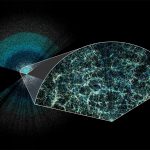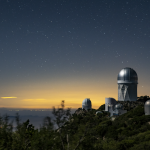galaxy
From CNET, November 13, 2022: View new photos of radiant galaxies released by NASA using the Dark Energy Camera, developed and tested by Fermilab, and the Hubble Space Telescope. These new images show galaxies scattered across the universe some 200 million light-years away.
From Big Think, August 13, 2022: After decades of research, astronomers cannot explain how and why galaxies exist. Fermilab’s Don Lincoln discusses the hypothesis of dark matter as the undiscovered form of matter to explain this galactic mystery.
From USA News Hub, May 10,2022: The Dark Energy Camera on the Víctor M. Blanco 4-meter Telescope, one of the most powerful cameras in the world just photographed two distant galaxies entwined in what’s been described as a “galactic ballet.” Read more about these amazing new images captured by the DECamera developed and tested at Fermilab.
From U Chicago News, April 12, 2022: Scientists from the University of Chicago and Fermilab have released an innovative new design for an experiment called the the Broadband Reflector Experiment for Axion Detection (BREAD) to find the mysterious substance is known as dark matter. BREAD, is especially promising because it can look for possible axions with a range of different masses.
From Science Times, January 31, 2022: The Hubble Space Telescope captured a stunning image of the Phoenix constellation with a group of galaxies collectively known as NGC that is approximately 450 million light-years away from Earth. The picture of three galaxies interacting was taken using a combination of the Hubble’s Advanced Camera for Surveys that includes the Dark Energy Survey Camera (DECam), developed and tested at Fermilab.
From CNN, November 4, 2021: Fermilab’s Don Lincoln examines the astronomical measurements recorded from a laboratory at the South Pole to explain one of the theories of, “How did the universe come into existence?”
From Phys.org, September 23, 2021: The Dark Energy Camera, developed and tested at Fermilab, captured images of the
the Fornax Cluster which is about 60 million light-years from Earth. It sits large in the night sky, stretching across more than 100 times larger than the full moon.
From Phys.org, Aug. 31: The Dark Energy Camera (DECam) developed and tested at Fermilab continues to make important discoveries. Astronomers have captured galaxy Centaurus A over 12 million light-years away and its size and proximity to Earth make it one of the best-studied giant galaxies in the night sky.


